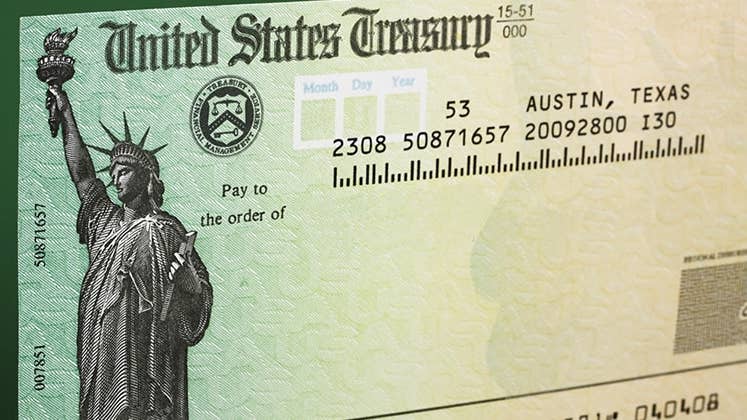
© karen roach/Shutterstock.com
The Internal Revenue Service says that the fastest way to get your refund is to have it directly deposited. Uncle Sam is so supportive of sending refunds straight to taxpayer accounts, he’ll even let you put the tax cash into 3 different accounts.
You can split your tax refund into, for example, a standard checking or savings account or even an individual retirement account or a myRA. Plus, you have a 4th refund option: using up to $5,000 of your tax money to purchase savings bonds.
The option to send your tax refund directly to several accounts was prompted by the increasing popularity of direct deposit.
Since direct deposit of tax refunds was introduced in 1987, it’s become one of the IRS’ most popular innovations.
Direct deposit of federal tax refunds in 2015
- 86.2 million returns.
- $255 billion in refunds.
- $2,957 average direct deposit refund amount.
You still can choose to have your entire refund sent to just one account. That option remains on the 1040EZ, 1040A and 1040. It’s also available on 1040s filed by nonresident and Puerto Rican taxpayers, as well as self-employed taxpayers who must file the 1040-SS.
But if you want to divide your refund into multiple accounts or buy savings bonds, you’ll have to send along Form 8888, Allocation of Refund, with your individual return. It can be sent along with whichever version of the 1040 you are filing.
Mind these important details
It’s not a difficult process or form. If you’ve used the single account direct deposit option before, there’s nothing to worry about other than the number of accounts you can enter.
Even if this is your first year to have your refund money sent electronically to a bank account, the directions are clear, and Form 8888 includes a blank check diagram showing you exactly what to look for and enter. But there are some things you need to pay attention to or your good deposit intentions could go astray.
First, be sure to check the box on your Form 1040 that indicates you are splitting up your refund. It will let the IRS know you want your money sent to multiple accounts and that agency employees need to look to your Form 8888 for details. The check box is on each of the various 1040 forms, just above where you would enter information if you were sending the money to just 1 account.
And about that 1040 section for a single direct deposit: Leave it blank. If you complete the account information on your main return, don’t be surprised if the IRS then sends all your refund money to that 1 account.
Instead of using your 1040 form, you’ll enter all your multiple account information on Form 8888.
Choose 1, 2 or 3 accounts
The form has room for 3 accounts, but that doesn’t mean you have to choose that many.
If you want your IRS cash deposited in only 2 accounts, that’s fine. All you have to do in this case is simply enter account information for the pair on Form 8888.
And if you’re happy with your refund going to 1, just enter that single account info in the appropriate section on your Form 1040.
Married couples can ask the IRS to directly deposit a refund on a joint return into individual accounts held by either partner or one held in both names. However, do verify that your financial institution will accept a joint refund sent to an individual account.
You do have to receive a minimum refund amount to use the split deposit option. But when the IRS says minimum, in this case, it means minimum.
As long as you request that at least $1 go directly into each account, the IRS will follow your instructions. So if your refund is $3, you can have one buck each sent to 3 accounts.
Savings bonds steps
Part II of Form 8888 is for the purchase of Series I bonds with tax refund money. Taxpayers who opt to buy these inflation-adjusted bonds — the interest rate is adjusted each May 1 and Nov. 1 — also have a choice of bond ownership.
You can purchase up to $5,000 in bonds. The only requirement is that the amount be a multiple of $50. For example, if your refund is $570, you can use up to $550 to buy bonds. Then you must select an account into which the IRS will directly deposit the remaining $20.
And there are some instances where you won’t get savings bonds. This will happen, for example, if your bond request isn’t a multiple of $50 or if your refund turns out to be smaller because you made a math error in your filing.
Different amounts to different accounts
There’s no requirement that you divide your refund equally among your accounts. If you’re getting back $1,000, you can send $900 to savings, $99 to a money market account and $1 to checking. Basically, as long as an account has a routing number, the IRS can send the money there directly.
But for any tax refund to go into an account, the money must be held in a U.S. financial institution, such as a bank, mutual fund, brokerage firm or credit union. And make sure the institution accepts direct deposits. Most do, but check just in case. A bank, for example, may accept direct deposits for regular savings accounts, but not for education savings accounts.
Also ask your financial institution about fees associated with electronic transactions. Again, that’s generally not a problem with deposits, but you don’t want any unpleasant surprises when you’re expecting your tax refund. If your bank does refuse a direct deposit, the IRS will send you that refund portion as a paper check.
In addition to standard checking and passbook savings accounts, you can send your refund directly to other financial instruments. Examples include money market accounts; health savings accounts, or HSAs; Archer medical savings accounts, or MSAs; and Coverdell Education Savings Accounts.
Watch out for potential IRA snafus
You can, though, direct your refund or a part of it to an individual retirement account, either a traditional account, a Roth IRA or, if you’re self-employed, a SEP IRA. But there are some details you need to consider.
First, set up your retirement account before you request the direct deposit to it, and let your IRA trustee know that the IRS will be transferring money into that account.
Also, be sure to tell your IRA trustee what tax year you want the refund deposit applied toward, because the transaction from the IRS won’t indicate that. If you don’t designate whether the refund is for a 2015 or 2016 contribution, the trustee can assume the deposit is for this year. That could pose a problem if you counted the refund deposit as a 2015 contribution and claimed a deduction for it.
If you are using the refund as a prior year contribution, also make sure you file early enough so that it’s directly deposited into your IRA by the April deadline.
It usually takes around 2 weeks for an e-filed direct deposit to be completed, but don’t run up too closely against the due date. If the money shows up in your account a day after the deadline, it will be counted as a 2016 contribution. Such bookkeeping differences could force you to refigure your tax bill and refund amount on an amended return.
Why we ask for feedback Your feedback helps us improve our content and services. It takes less than a minute to complete.
Your responses are anonymous and will only be used for improving our website.





